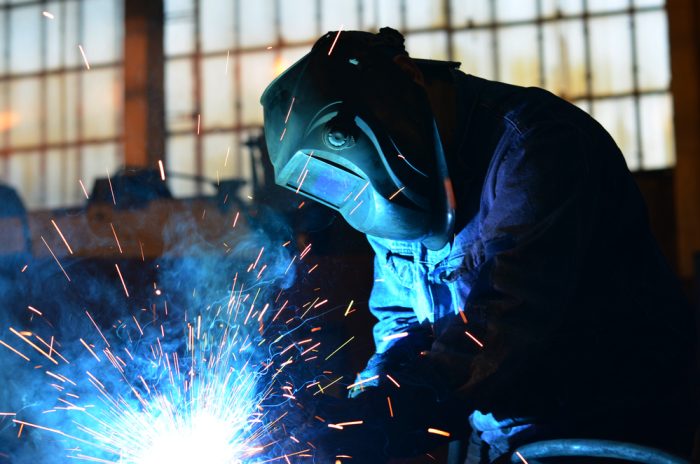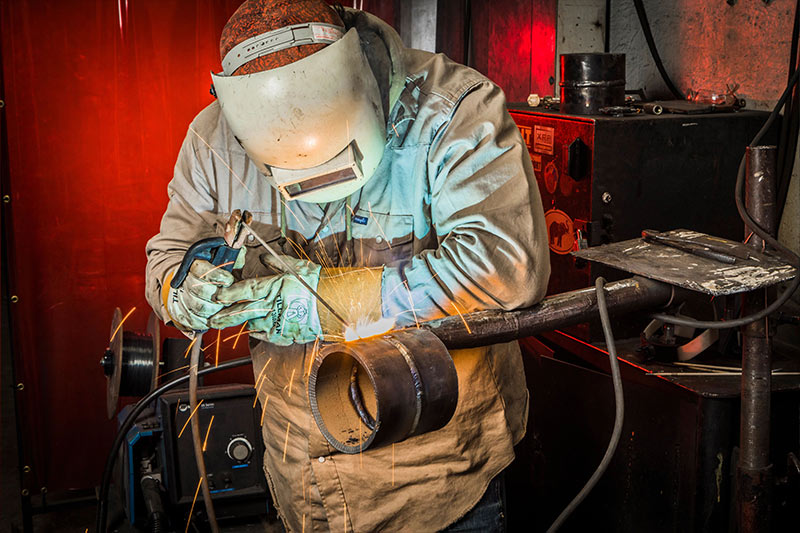Usual Welding Repair Issues and Exactly How to Address Them Effectively
Welding repairs typically run into a variety of concerns that can endanger the stability of the final item. Usual problems include poor infiltration, porosity, and misalignment, among others. Each issue presents unique difficulties that require details approaches for resolution. Understanding these problems is necessary for welders aiming to improve their abilities and outcomes. This conversation will certainly discover these typical welding repair work issues and reliable approaches to address them.
Poor Penetration
Inadequate infiltration occurs when the weld metal falls short to completely fuse with the base material, resulting in weak joints and possible structural failings. This problem commonly originates from not enough heat input, inaccurate electrode angle, or incorrect welding rate. Welders might experience inadequate infiltration because of a mistake of the required criteria for a details product thickness or kind. Furthermore, contamination on the base product's surface area can impede reliable bonding, worsening the problem. To deal with poor penetration, welders need to guarantee appropriate settings on their equipment and maintain a clean work surface. Routine examination of welds is suggested to identify any kind of shortages early, permitting timely modifications and the avoidance of jeopardized architectural integrity in bonded settings up.
Porosity
Porosity is a common problem in welded joints that shows up as little gas bubbles entraped within the weld steel. This flaw can jeopardize the stability of the weld, resulting in minimized strength and potential failure under anxiety. Montana Mobile Welding and Repair Belgrade Fabrication. Porosity typically arises from contamination, dampness, or improper welding methods, which permit gases to escape into the liquified weld pool. To address porosity, welders need to assure correct surface area prep work, keep a tidy workplace, and use suitable welding parameters. Furthermore, picking the appropriate filler material and protecting gas can mitigate gas entrapment. Normal evaluation and screening of welds can help determine porosity early, guaranteeing prompt corrective actions are taken, consequently preserving the high quality and integrity of the welded structure
Imbalance
Misalignment in welding can occur from numerous factors, including improper arrangement and thermal growth. Recognizing the source is crucial for efficient resolution. Several adjustment methods are readily available to realign parts and guarantee architectural integrity.
Reasons of Imbalance
Welding imbalance frequently comes from a variety of underlying problems that can compromise architectural honesty. One key cause is incorrect fit-up of elements before welding, which can result in spaces and uneven surface areas. Variations in thermal development during the welding process can also cause distortion, particularly if the products being joined have different coefficients of expansion. Additionally, poor fixturing and clamping might fall short to hold parts safely in place, resulting in movement throughout welding. Poorly kept tools, including welding equipments and tools, may introduce variances in the weld grain, additional contributing to misalignment. Operator error, stemming from insufficient training or experience, can likewise play a considerable function in producing misaligned welds.

Correction Methods Readily Available
Dealing with imbalance efficiently requires a mix of rehabilitative techniques tailored to the certain problems at hand. One typical approach is using fixtures or jigs to hold components in the right setting during welding, making sure regular placement. Additionally, pre-heating the products can help minimize distortion and improve fit-up. For substantial imbalance, mechanical realignment strategies, such as making use of hydraulic jacks or clamps, can be utilized to correct the setting prior to welding. Post-weld warmth therapy might likewise be required to soothe tensions brought on by imbalance. Ultimately, mindful evaluation and change throughout the configuration stage can protect against misalignment issues from coming to be substantial problems, advertising a smoother welding procedure and enhancing total structural honesty.
Distortion
Distortion is an usual challenge in welding that can develop from numerous elements, consisting of unequal heating & cooling. Comprehending the root causes of distortion is necessary for carrying out reliable avoidance methods. Addressing this concern not just improves architectural integrity but additionally boosts the general quality of the weld.
Root causes of Distortion
When based on the intense warmth of welding, materials usually undergo modifications that can cause distortion. This sensation largely emerges from thermal development and tightening during the welding procedure. As the weld area heats up, the material expands; upon cooling, it gets, which can produce inner stresses. On top of that, uneven heating throughout a work surface can worsen these stress and anxieties, resulting in bending or flexing. The sort of product also plays a significant role; metals with varying thermal conductivity and coefficients of development may react in a Full Article different way, bring about uncertain distortions. In addition, inadequate joint layout and insufficient fixturing can add to imbalance throughout welding, raising the chance of distortion. Comprehending these causes is necessary for reliable welding fixing and prevention approaches.
Avoidance Techniques
Effective prevention methods for distortion during welding emphasis on controlling warm input and ensuring correct joint style. Keeping a regular warm input assists to reduce thermal growth and contraction, which can result in distortion. Utilizing methods such as pre-heating the work surface can likewise reduce the temperature gradient, advertising uniform heating. Additionally, choosing appropriate joint designs, such as T-joints or lap joints, can improve stability and minimize stress focus. Executing correct fixturing to secure the workpieces in location even more help in preserving placement during the welding procedure. Ultimately, staggered welding sequences can distribute warmth more equally, avoiding local distortion. By using these techniques, welders can greatly reduce the likelihood of distortion and improve the total top quality of their welds.
Breaking
Fracturing is an usual concern come across in welding fixings, frequently arising from numerous factors such as incorrect cooling prices, product selection, or inadequate joint prep work. The incident of splits can greatly endanger the honesty of the weld, bring about possible failures throughout procedure. To resolve this problem, welders need to first examine the origin, making sure that products work and properly chosen for the details application. Furthermore, managing the cooling price during the welding process is important; fast cooling can induce tension and result in splitting. Appropriate joint style and prep work likewise add to minimizing the threat. Executing these techniques can improve weld quality and toughness, eventually minimizing the likelihood of cracking in completed weldments.

Incomplete Blend
A substantial problem in welding repair work is insufficient combination, which occurs when the weld steel does not appropriately bond with the base material or previous weld passes - Montana Mobile Welding and Repair Belgrade. This defect can result in weak points in the joint, possibly endangering the stability of the welded framework. Factors adding to incomplete fusion consist of insufficient warm input, inappropriate welding method, and contamination of the surfaces being signed up with. To address this issue properly, welders need to guarantee appropriate pre-weld cleaning and surface area preparation, in addition to readjust their welding specifications to attain appropriate penetration and blend. Regular assessment throughout the welding process can also help determine insufficient combination early, enabling prompt corrective actions to boost the overall top quality of the weld
Overheating
While welding repair services can improve architectural stability, overheating provides a significant difficulty that can result in material deterioration. Extreme heat throughout welding can alter the mechanical homes of steels, leading to minimized strength, enhanced brittleness, and useful link bending. This sensation is especially crucial in high-stress applications where structural dependability is vital. Identifying overheating can involve visual examinations for discoloration or distortion, as well as checking temperature level throughout the welding procedure. To alleviate the threats connected with getting too hot, welders need to utilize ideal methods, such as regulating heat input, readjusting travel speed, and utilizing ideal filler materials. Furthermore, executing pre- and post-weld warmth therapies can help bring back product properties and improve the total top quality of the fixing, ensuring long-lasting efficiency and security.
Frequently Asked Inquiries
What Are the Common Indications of a Welding Defect?

Just How Can I Evaluate My Welds for Top quality?
To check welds for high quality, one can utilize aesthetic evaluations, ultrasonic screening, and radiographic methods. Each method assures structural honesty, recognizes issues, and verifies adherence to defined standards, eventually enhancing the reliability of the welded joints.
What Safety Preventative Measures Should I Take While Welding?
When welding, one should focus on security by using proper personal safety tools, ensuring appropriate air flow, protecting flammable products away, maintaining a clean workspace, and recognizing surroundings to stop injuries and mishaps.
Can I Fix a Weld Without Redesigning the Entire Joint?
Fixing a weld without redesigning the entire joint is possible, depending on the damage (Montana Mobile Welding and Repair Fabrication). Methods such as grinding, including filler material, or using a welding process can efficiently deal with particular problems while preserving the bordering framework
What Equipment Are Essential for Efficient Welding Repair Works?
Essential tools for reliable welding fixings consist of a welding maker, cord brush, grinder, protective equipment, clamps, and filler materials. Each device plays an important duty in guaranteeing top quality and safety during the repair work procedure. Porosity commonly occurs from contamination, wetness, or improper welding techniques, which enable gases to run away right into the molten weld swimming pool. Inadequately conserved devices, including welding makers and tools, may present incongruities in the weld grain, additional contributing to misalignment. When subjected to the intense warmth of welding, check out here products often undertake modifications that can lead to distortion. Breaking is an usual issue encountered in welding repair work, frequently resulting from various aspects such as improper air conditioning prices, product option, or poor joint prep work. A significant concern in welding repair work is incomplete combination, which takes place when the weld steel does not effectively bond with the base material or previous weld passes.